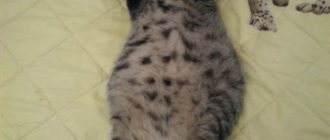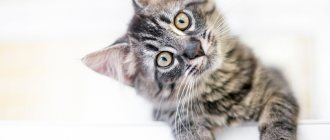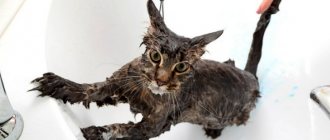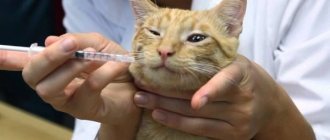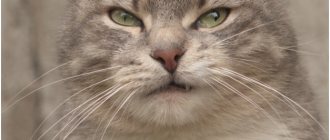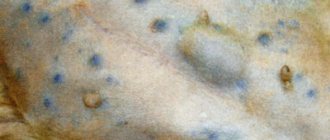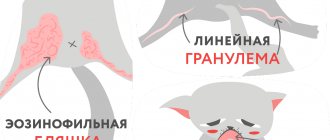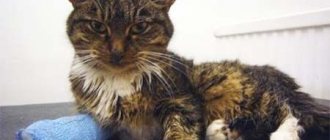Ascites is dropsy of the abdominal cavity in cats. The idea that this is a separate disease is erroneous. Ascites develops against the background of a chronic pathology that has developed in the body, and is characterized by the accumulation of fluid in the abdominal cavity, which exceeds normal levels.
Excess intrauterine fluid puts pressure on the internal organs, making it difficult for them to function. The process is dangerous because dangerous complications, including death, will arise in the pet’s body.
Why does ascites develop?
Absolutely any animal can suffer from ascites, but cats that lead a sedentary lifestyle are most susceptible to this pathological condition. A small volume of serous fluid is always present in the abdominal cavity.
Excessive fluid volume above normal poses a danger to the body.
Excessive accumulation of fluid in the abdominal cavity can be caused by the following factors:
- cardiovascular pathologies;
- renal failure;
- liver diseases;
- decreased albumin levels;
- hepatitis;
- diabetes;
- tuberculosis;
- peritonitis;
- infections, parasites, fungi;
- weak immunity;
- overweight;
- hormonal imbalances;
- oncology;
- abdominal injuries that provoked an inflammatory process in the abdominal cavity;
- bladder rupture;
- nephrotic syndrome;
- excess salt in the diet, economy-class food and, as a result, an increase in sodium concentration;
- violation of water-salt and protein metabolism.
This is not a complete list of the reasons leading to abdominal dropsy in cats.
Organ enlargement
Various abdominal organs may increase in size, resulting in bloating.
Liver, spleen or kidneys
Enlargement of the liver, spleen or kidneys can occur as a result of a benign or malignant neoplasm. This can happen either as a result of tumors growing into the walls of organs, or as a result of solitary lesions, certain types of infections (especially fungal infections), accumulation of inflammatory cells, or a reaction to a disease in another part of the body.
Bladder
An enlarged bladder and difficulty urinating may be signs of a urinary tract blockage, a potentially life-threatening condition. It is more common in males, but can also occur in females.
Gastrointestinal tract
The gastrointestinal tract can be filled with gas, fluid, foreign material, and even food. This leads to bloating. The most dangerous of the above is blockage of the gastrointestinal tract by a foreign object.
Uterus
In unspayed cats, the uterus may become enlarged due to pregnancy or as a result of the accumulation of fluid or pus. The latter can be life-threatening.
After spay surgery, your cat may experience temporary bloating if she is overly active after surgery or if she has a reaction to the stitches. Therefore, it is important for your pet to rest while recovering from surgery. If the owner notices signs of inflammation, contact a veterinarian immediately.
Clinical picture
The initial stage of the pathological condition is virtually asymptomatic, since the accumulation of fluid in the abdominal cavity is a gradual process. Characteristic signs can only be noticed when the volume of fluid significantly exceeds normal levels. Ascites can be suspected by a noticeably swollen abdomen and stretching of the sides when the animal is active.
Symptoms:
- the abdominal cavity is swollen, hard to the touch;
- fluctuation - when pressing on the abdomen, you can feel the liquid inside it swaying;
- the belly takes on the shape of a pear when the cat stands on its hind legs, and inflates and rounds when taking a sitting position;
- dullness and disheveled fur;
- yellowish tint of mucous membranes;
- paws, ears, crotch, sternum swell;
- vomiting, nausea;
- lack of appetite;
- constipation or diarrhea;
- breathing problems, hoarseness, shortness of breath;
- weakness, apathy.
It is very important to distinguish ascites from ordinary overeating.
Symptoms of the disease
Ascites in cats manifests itself in the form of clearly expressed symptomatic signs. The main ones include:
- bulging of the abdominal cavity on both sides;
- respiratory disorder;
- unkempt appearance of the coat;
- yellowness of mucous membranes;
- the formation of edema on the limbs and ears.
To confirm the diagnosis, it is necessary to place the cat in an upright position and raise its front paws. The owner will be able to detect the so-called “draining” of the abdomen, which will be a clear confirmation of the presence of ascites.
The number of symptomatic manifestations may vary depending on the severity of the pathological process.
Additional symptoms of ascites in a cat include disruption of the bowel movement process, vomiting, temporary loss of consciousness and anxiety of the animal due to the resulting pain syndrome.
The subsequent life of the pet depends on how quickly the disease is identified and therapy is started.
Diagnostics in a veterinary clinic
The diagnostic task is to differentiate ascites from other diseases with similar symptoms, for example, from exudative peritonitis. Thus, with peritonitis, an increase in temperature, pain when pressing on the abdomen, and a significant number of leukocytes and proteins are observed.
And finally, the most obvious sign of peritonitis is the transience of the disease. With ascites, as mentioned above, the disease has a long development.
Necessary diagnostic methods for suspected ascites include:
- taking anamnesis;
- analysis of clinical symptoms;
- palpation of the abdominal cavity;
- urine and blood tests;
- X-ray of the peritoneum, sternum;
- Ultrasound of the chest and abdominal cavity;
- fluid examination;
- endoscopy;
- biopsy.
Differential diagnosis helps to identify the underlying pathology that caused ascites. Without determining the provoking factor, it is impossible to prescribe adequate treatment, since the amount of fluid will increase with each relapse.
Diagnostic measures
After the animal arrives at the veterinary clinic, the doctor begins an examination. During palpation, a significant increase in the walls of the peritoneum is detected.
The veterinarian should gather as much information as possible regarding the symptoms, especially their duration and severity.The liquid is subjected to laboratory testing. A puncture is made to collect the material. At the same time, urine and blood tests are performed, as well as radiography and ultrasound.
In most cases, the disease develops within a few hours.
Can ascites in cats be treated or not?
Treatment of ascites is carried out comprehensively. Therapy is aimed at eliminating the underlying disease, alleviating pain symptoms and strengthening the immune system.
To reduce the amount of fluid in the abdominal cavity, laxatives and diuretics (Furosemide, Temisal) are indicated.
To stabilize the functioning of the cardiovascular system, drugs such as Olitorizide, Strophanthin, Digitoxin, Cardiovalen are necessarily prescribed.
If there is an infection in the body, antibiotic therapy using drugs from a number of cephalosporins is indicated.
To strengthen the walls of blood vessels and reduce their permeability, the veterinarian prescribes intravenous solutions of calcium chloride (10%).
To pump out the fluid, a puncture is done when the veterinarian pierces the abdominal wall. The procedure is performed at least twice a week. In this case, the removal of ascitic fluid must be compensated by reinfusion of ascitic transudate or administration of an albumin solution. These procedures provide a chance for additional remission and prolongation of the animal’s life.
The course of treatment depends on the condition of the animal and the amount of fluid. This is a long process that must continue until the clinical signs of dropsy completely disappear.
As for the prognosis, with adequate and, most importantly, timely therapy, it is favorable. If you do not seek help from a specialist in time, the volume of fluid will continue to increase, and this is fraught with pressure on the internal organs and disruption of their functions.
Intestinal parasites
Causes of bloating in cats may include gastrointestinal parasites, notes the Cornell Feline Health Center. This is more common in kittens, as they are more likely to become infected with worms. Your veterinarian can identify intestinal parasites by testing your cat's stool. Treatment usually involves taking oral antiparasitic medications.
What should the owner do
Under no circumstances should you play Aibolit or give your pet medications without consulting a veterinarian. Only a specialist can prescribe medications and set their dosage, based on the severity of the pathology, general condition and age of the animal.
Uncontrolled use of medications can lead to potassium being excreted from the body along with urine. This will worsen the cat’s well-being and lead to complications, even to the point where the animal dies. Human diuretics are especially dangerous in this regard.
Increasing their dosage independently can lead to disturbances in the level of electrolytes and leaching of fluid from the microcirculation network. This is fraught with the possible development of encephalopathy.
At the first opportunity, you should take the animal to the clinic so that the doctor can examine it and prescribe appropriate treatment.
A cat with abdominal hydrops is prescribed a therapeutic diet that involves limiting the consumption of water and any other liquid. The food of a sick pet should be nutritious, balanced in vitamins, minerals and carbohydrates and consist mainly of proteins.
The diet includes meat, poultry, sea fish, cottage cheese, kefir. You can add salt to food, but the amount of salt should be minimal.
Prevention and care
As with any disease, after treatment, dropsy in cats requires preventive measures. After surgery, your pet requires special care in a quiet environment.
Preventive measures include regular monitoring of the animal’s health by a specialist. In addition, it is necessary to completely cure him of chronic diseases, which from time to time can be the main irritants of such ailments as ascites.
Preventative measures also include restoring proper nutrition for the pet. Food is one of the most influential factors on an animal's health. The diet should be saturated with the required amount of proteins, fats and carbohydrates.
An active lifestyle for a cat can save him from accumulating excess calories. Different degrees of obesity can become conductors not only for ascites, but also for other serious diseases of cardiac inclination.


